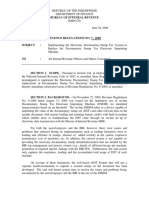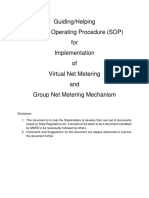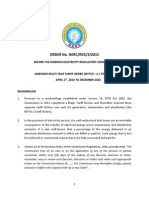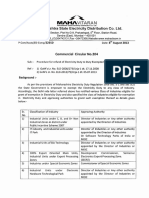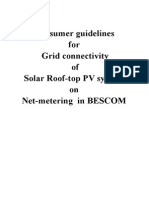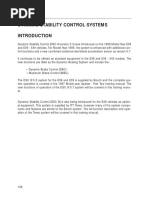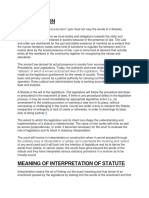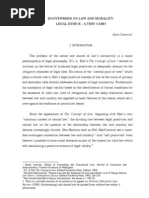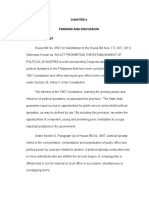0530 0008 PDF
0530 0008 PDF
Uploaded by
Daniel HunterCopyright:
Available Formats
0530 0008 PDF
0530 0008 PDF
Uploaded by
Daniel HunterOriginal Title
Copyright
Available Formats
Share this document
Did you find this document useful?
Is this content inappropriate?
Copyright:
Available Formats
0530 0008 PDF
0530 0008 PDF
Uploaded by
Daniel HunterCopyright:
Available Formats
NEM SETTLEMENTS PROCESS
PREPARED BY:
Electricity Metering & Settlements
DOCUMENT NO:
N/A
VERSION NO:
6.3
PREPARED FOR:
National Electricity Market
FINAL
NEM Settlements Process
Important Disclaimer
This document is made available to you on the following basis:
(a) Purpose This document is provided to you for information purposes only. You are not
permitted to commercialise it or any information contained in it.
(b) Reliance This document may be subsequently amended. Any reliance on this
document is at your own risk.
(c)
Intellectual Property AEMO Limited is the owner of the copyright in this document.
All rights are reserved. All material is subject to copyright under the Copyright Act 1968
(Commonwealth) and permission to copy it, or any parts of it, must be obtained in writing
from AEMO. AEMO is the owner of all other intellectual property rights in this document
and the information contained in it. You must not in any way, or by any means, store,
reproduce or modify it without AEMO's express written consent.
(d) No Warranty - Neither AEMO, nor any of AEMOs advisers, consultants or other
contributors to this document (or their respective associated companies, businesses,
partners, directors, officers or employees) make any representation or warranty, express
or implied, as to the currency, accuracy, reliability or completeness of this document, or
the information contained in it.
(e) No Liability - To the maximum extent permitted by law, neither AEMO, nor any of its
advisers, consultants or other contributors to this document (or their respective
associated companies, businesses, partners, directors, officers or employees) shall have
any liability (whether arising from negligence or otherwise) in respect of your use of the
information (including any reliance on its currency, accuracy, reliability or completeness)
contained in this document.
[2009] - AEMO Limited is the owner of the copyright in this document. All Rights reserved
2009
NEM Settlements Process
NEM Settlements Process
Version Control
VERSION
DATE
DETAILS
Version 5
Nov 2006
Introduced Exigo (Austraclear cash transaction system) Previous
papers did not log version history
Version 6
Aug 2007
Spot Market Operations Timetable Rules 4.2 amended to:
1. move the obligation for Market Participants to pay AEMO in
cleared funds by 10:00am (Sydney Time) to 10:30am (Sydney
Time) on Settlement Day (+20 business days);
2. clarify AEMOs payment time obligations to pay in cleared funds
to Market Participants on Settlement Day (+20 business days)
if:
a) All payments to AEMO are cleared by 10:30am and
b) Participants, to be paid by NEMCO, have entered their
settlement transactions into Exigo by 13:00 Sydney Time
6.3
Nov 2009
Update to AEMO Format
2009
NEM Settlements Process
II
NEM Settlements Process
Table of Contents
1.
INTRODUCTION
2.
SETTLEMENT STATEMENTS
2.1
Data Collection for Energy Trading
2.2
Retail Transfer Process
2.3
Statement Production
2.4
Revised Settlement Statements
3.
FINANCIAL SETTLEMENTS
3.1
Introduction
3.2
Principles
3.3
Settlement Process
3.3.1
EFT Agent
3.3.2
AEMO Receipts
3.3.3
AEMO Payments
3.3.4
Default Procedure
2009
NEM Settlements Process
III
NEM Settlements Process
1.
INTRODUCTION
In accordance with the National Electricity Rules as amended (the Rules), AEMO must
provide, for Market Participants registered under the provisions of Chapter 2, a financial
settlement service for the billing and clearance of all market trading transactions under
Chapter 3 of the Rules including:
spot market transactions;
reallocation transactions; and
ancillary service transactions.
AEMO also provides a settlement service for Registered Participants who participate in the
Settlement Residue Auction.
The purpose of this paper is to set out the processes to be used by AEMO in relation to
settlements, rather than exhaustively detail all Rules requirements or procedural steps
concerning these matters. Accordingly, these guidelines should be read in conjunction with
Chapters 2 and 3 of the Rules and the Spot Market Operations Timetable available on
AEMOs website.
This paper addresses only the settlement and clearing activities undertaken by AEMO.
The prudential supervision activities are discussed in the paper NEM Settlement Prudential
Supervision Process which is available on the AEMO website.
Settlement Residue Auction information can be found in the AEMO Settlement Residue
Auction Information Memorandum and the Auction Participant Agreement document which
are published on the AEMO website.
2.
SETTLEMENT STATEMENTS
2.1
Data Collection for Energy Trading
A Billing Period is a period of seven days commencing at the start of the trading interval
ending 12:30 am Sunday and includes 336 half hour trading intervals. A Trading Interval
comprises six five-minute dispatch intervals.
Regional Reference Prices for each half hour trading interval are determined by
averaging the six embedded dispatch interval prices immediately after those dispatch
prices are published. The Regional Reference Prices are already available to AEMO in
the Market Management System (MMS).
Metering Data Providers (MDPs) download electricity metering data through
communication links after the end of each billing period. i.e. after Saturday 2400 hours.
The energy flows through the connection points are recorded as half hourly values,
validated for completeness and substituted with estimated values to replace any missing
or incorrect values.
In the case of connection points which are not large enough to require metering
communication links under the jurisdictional metrology procedures, the MDPs estimate
the interval metering data or the date and value of the next manual meter read and
forward this information to AEMO.
The MDP passes the validated metering data to AEMO by the second business day after
the end of the billing period (normally a Tuesday).
2009
NEM Settlements Process
Page 4 of 10
NEM Settlements Process
The Market Management System (MMS) software supports the various functions
comprising market operations, including bidding, dispatch, pricing and settlements. The
storage and aggregation of metering data to the transmission connection point level is
carried out by the Metering Settlement and Transfer Solution (MSATS). The MSATS
system converts the monthly or 3-monthly energy readings of consumption meters to half
hourly profiles based on the net system load profiles for each distribution network area.
The wholesale market electricity transactions for each Market Participant for each trading
interval are calculated using the Regional Reference Price, relevant transmission loss
factors and metered data values for the relevant connection points. The transaction
results for each interval are summed over the entire billing period to determine the
settlement amount for wholesale market electricity for each Market Participant in the
billing period.
2.2
Retail Transfer Process
Consumers of electricity can elect to be supplied by a retailer other than their local
(franchise) retailer when their annual consumption exceeds the current threshold limit, if
any, determined by the State jurisdictions. The thresholds have been reduced in stages,
and have been removed in NSW, SA, VIC and Queensland from 2007.
As each consumer is transferred, its metered energy consumption from that day forward
is subtracted from the total boundary metering of its franchise retailer and is added to the
energy account of the new retailer of choice. This is also referred to as Settlements by
difference.
2.3
Statement Production
The Annual Settlements Calendar shows the dates for delivery of statements and
settlement of trading amounts relating to each weekly period. The Monthly Settlement
Calendar shows the dates for delivery of statements and settlement trading amounts
relation to each weekly billing period. Both documents include posting dates for 20 week
and 30 week revision. Both documents are published on the AEMO website.
The settlement amount for wholesale market energy traded over a billing period is
consolidated with other transactions for ancillary service payments and recoveries,
reallocation, intervention payment and recovery, GST and Market Participant fees for
inclusion in the Preliminary Statement. These statements are sent to Market Participants
within five business days after the billing period (normally a Friday).
(Clause 3.15.14)
The Preliminary Statement is an indication of the amounts to be included in the final
statement, enabling Market Participants to refine their cash flow projections and refer any
apparent discrepancies for investigation and amendment if necessary. The Rules
require Market Participants and AEMO to use reasonable endeavours to resolve
disputes about Preliminary Statements before the corresponding Final Statement is
issued.
(Clause 3.15.18)
Within eighteen business days after the billing period (normally a Wednesday), the
calculations are redone to incorporate any changes to metering data, or billing
configuration and the Final Statement is issued at around 12 noon to Market Participants.
(Clause 3.15.15)
For all statements, additional supporting data used in the calculations will be available for
the Market Participants from the Market Management System shortly after the statement
is issued. The supporting data includes half-hour results and is available either as CSV
files or in database form from the Infoserver.
2009
NEM Settlements Process
Page 5 of 10
NEM Settlements Process
The net settlement amount shown on the Final Statement is due and payable on the
twentieth business day after the billing period (normally a Friday) or two business days
after receiving the final statement, whichever is later. Under the Rules convention,
positive amounts are payable by AEMO to the Market Participant, and negative amounts
are payable by the Market Participant to AEMO. Financial settlement is covered under
section 3 of this paper.
(Clause 3.15.16
+ 3.15.18)
2.4
Revised Settlement Statements
It is not practical for all inaccuracies in the metering data to be identified and remedied by
the time the Final Statement is issued. This is due to the large amount of metering data
to be processed, and because discrepancies, when discovered, may have been affecting
results for more than a month. Under full retail competition, a growing percentage of
meters are read on a quarterly basis. Estimated values are used to prepare final
statements pending the availability of the actual readings from these meters.
Disputes raised with AEMO within 6 months of the end of the disputed billing period, may
lead to changes in the settlement results. Any financial adjustments arising from these
changes are accounted through revised settlement statements.
Routine revised statements for a billing period are issued at approximately 20 weeks and
again at approximately 30 weeks after that billing period to cover outstanding minor
adjustments, if any. This arrangement provides for orderly and systematic processing of
revisions, and keeps the number of revisions to a minimum.
An adjustment is considered to be major if it represents an amount exceeding 5% of the
Market Participants settlement amount for the billing period. Major adjustments and
adjustments from resolutions of formal disputes may result in the issue of special revised
statements as soon as practicable, to minimise the distortion to Participant cash flows.
(Clause 3.15.19(a))
Any adjustment resulting from the issue of a revised settlement statement is incorporated
into a final statement issued between 8 and 13 business days later.
(Clause 3.15.19)
3.
FINANCIAL SETTLEMENTS
3.1
Introduction
AEMO is charged under the Rules to administer and operate the National Electricity Market
(the Market), including a Market clearing role. When selling or purchasing electricity or
settling other market transactions, Market Participants deal with AEMO, rather than with each
other.
The Rules provide limits on recourse to ensure that AEMOs obligations to make payments to
Generators are limited to the money available to AEMO from receipts from Market
Participants. If this did not occur then there would be a need for a large source of capital,
either on AEMOs balance sheet or available from some other source, to meet a default.
2009
NEM Settlements Process
Page 6 of 10
NEM Settlements Process
Generators
Customers
Generator A
Customer 1
(Limited Recourse Principal)
Generator B
Generator C
AEMO
Customer 2
Customer 3
Any shortfall in AEMOs recovery from any Market Participant in relation to a billing period is
shared across the generators of electricity by reducing the amount paid to them for electricity
supplied through the Market in that billing period.
3.2
Principles
All payments to AEMO and by AEMO are as cleared funds, and transactions are not
completed until they clear.
Austraclears electronic Exigo Settlement System is used by all Market Participants.
All market transactions in the weekly billing period, adjustments for prior billing periods
and Participant fees are combined into a single settlement amount per Participant each
week.
Participants pay amounts due to AEMO on settlement date and AEMO pays amounts
due to participants on the same day.
The existence of a dispute is not a valid basis under the Rules for withholding settlement
payments. Further information about AEMOs dispute resolution process is available
from the AEMO Information Centre on 1300 361 011.
(Clause 3.15.16)
Settlements process is underpinned by prescribed deadlines for payment in accordance
with the Spot Market Operations Timetable.
If deadlines for payment are not met then settlement default procedures are invoked as
described in the NEM Settlement Prudential Supervision Process paper on the AEMO
website.
3.3
Settlement Process
Note: In this section S refers to the settlement date and the number following S-2 refers to
the number of days before or after the settlement date.
2009
NEM Settlements Process
Page 7 of 10
NEM Settlements Process
3.3.1
EFT Agent
The Rules require AEMO to arrange an EFT mechanism for settlements and the
collection and payment of Market fees.
(Clause 3.15.2)
(Clause 3.15.2)
AEMO uses Austraclear as the provider of the EFT settlement facility called Exigo, for
the following reasons:
transparency of the process in tracing status of transactions for both AEMO and
Market Participants;
cleared fund settlements are underpinned by Austraclears role in the Real Time
Gross Settlement (RTGS) environment. This means that once a transaction has
cleared, it cannot be unwound later in the day; and
Austraclears provision of Electricity Associate Membership provides a low cost
framework that does not disadvantage smaller Market Participants.
Cash transfers in Austraclear require two sides of a transaction to be entered - one by
the sender and one by the receiver. When both sides are entered and matched, the
cash transfer is processed through the RTGS system, and cleared funds either received
or paid.
In order to trace transactions with an effective audit trail to/from Market Participants, it is
necessary for each registered Market Participant to have a unique Austraclear code for
which financial responsibility is taken.
A Market Participant may elect to use a single Austraclear identifier to cover transactions
relating to more than one Market Participant identifier in the MMS.
3.3.2
AEMO Receipts
The MMS produces final statements for dispatch to Market Participants two business
days prior to the settlement date (S-2), which is 18 business days after the end of the
billing period. Each Market Participants statement identifies settlement amount by class
of transaction, along with a net settlement amount payable by/to that Market Participant.
Transactions payable to AEMO (ie where AEMO is receiving funds from Participants) are
entered electronically into Austraclear by AEMO, as the first side of payments to AEMO
(S-2).
Market Participants paying to AEMO must pay in cleared funds by 10:30am (Sydney
time) on settlement day (So).
Market Participants must ensure that their transactions are completed by the required
time. Liasing with their banking representatives is essential for this process to occur
successfully. Please refer to the AEMO paper Austraclear: Participant Settlement
Responsibilities which is published on the AEMO website.
Matched Austraclear transactions are processed via RTGS. Therefore AEMO receives
electronic confirmation of cleared funds from Austraclear in real time.
(Clause 3.15.16)
After confirmation by AEMO that full receipts are received from all paying Market
Participants, the AEMO Full Payment process takes place as described in section 3.3.3.
If all receipts are not cleared by 10:30am, then the Short Payment is commenced as set
out in section 3.3.4.
2009
NEM Settlements Process
Page 8 of 10
NEM Settlements Process
3.3.3
AEMO Payments
AEMO Payment transactions are entered into Austraclear by automatic file transfer from
MMS after confirmation that all receipts have been received prior to 2pm on settlement
day (So).
Receiving Market Participants also enter Austraclear transactions to confirm payments to
them. Market Participants may enter these transactions anytime after the posting of the
relevant final statement (S-2). However AEMO will not enter the Austraclear transactions
until all receipts have been received on settlement day (So).
Matched transactions are processed via RTGS. Creditor Market Participants receive
confirmation of cleared funds.
AEMO pays to Creditor Market Participants in cleared funds the amount stated on the
relevant final statement by 2pm Sydney time, should the transactions be matched by
1:00pm.
3.3.4
(Clause 3.15.21 (a)(1))
Default Procedure
If one or more receipts have not been cleared before the 10:30am deadline, AEMO
becomes aware of this through the Austraclear facility and confirms by telephone contact
with the relevant Market Participant(s). This is a default event as defined in the Rules.
Upon recognising the default event AEMO may :
(Clause 3.15.21 (b) )
issue a Default Notice to the defaulting Market Participant(s), to be remedied within
24 hours of the Default Notice being issued, and/or
draw upon credit support or security deposits provided by the defaulter(s) in order to
recover funds necessary to meet settlement payment obligations from the relevant
credit support providers.(see NEM Settlement Prudential Supervision Process, which
is available on the AEMO website, for further details.)
The Maximum Total Payment amount is the total payment amount AEMO was due to
receive, less the amount of shortfall in receipts, plus any payments received from credit
support providers by 2:00pm. If credit support payments received cover the shortfall,
then no reduction in payments is necessary. Otherwise, reductions to individual
payments for energy and reallocation transactions of receiving Market Participants are
determined on a pro-rata basis as detailed in the Rules.
(Clause 3.15.22)
AEMO notifies creditor Market Participants of the payment reductions.
Reduced payments are processed through Austraclear as per section 3.3.3 above by
4:00pm on So, with reduced transaction amounts.
If all or part of the default amount is recovered by AEMO on a later date, then those
recoveries will be returned to the short-paid Market Participants on a pro-rata basis.
(Clause 3.15.23)
2009
NEM Settlements Process
Page 9 of 10
You might also like
- 1 RR 7-2009Document5 pages1 RR 7-2009JoyceNo ratings yet
- RMC No. 72-2018Document8 pagesRMC No. 72-2018Larry Tobias Jr.No ratings yet
- AESO ENERGY TRADING SYSTEM TRAINING Course Net Settlement Instructions VersionDocument19 pagesAESO ENERGY TRADING SYSTEM TRAINING Course Net Settlement Instructions VersionJustyna LipskaNo ratings yet
- 25 Landmarks of FreemasonryDocument7 pages25 Landmarks of FreemasonryAntoun Omar YazbecNo ratings yet
- CHAPTER 4 ObliconDocument6 pagesCHAPTER 4 ObliconAleezah Gertrude Regado100% (1)
- CGL Presentation BrokersDocument23 pagesCGL Presentation BrokersAnonymous brpVlaVBNo ratings yet
- Different Types of Electricity Markets Modelled Using PLEXOS Integrated Energy Model - The UK Balancing Market ExampleDocument7 pagesDifferent Types of Electricity Markets Modelled Using PLEXOS Integrated Energy Model - The UK Balancing Market ExampleHarish B. M.No ratings yet
- PPE WESM Billing, Settlement, & Metering (Document)Document17 pagesPPE WESM Billing, Settlement, & Metering (Document)Darelle David MalacaNo ratings yet
- WESM Participant Handbook Vol3Document18 pagesWESM Participant Handbook Vol3Leizza Ni Gui DulaNo ratings yet
- File f-1677125380531Document52 pagesFile f-1677125380531Logesh KumarNo ratings yet
- Retail Manual On Validation Timeline Adjustment in Metering and BillingDocument10 pagesRetail Manual On Validation Timeline Adjustment in Metering and BillingTabanginSnsNo ratings yet
- 7_Training on Market Structure_Role of Entities_ismo_mUwYAL37OCDocument9 pages7_Training on Market Structure_Role of Entities_ismo_mUwYAL37OCSajawal HayatNo ratings yet
- All Power ExchangeDocument7 pagesAll Power ExchangeShroff HardikNo ratings yet
- WESM Briefer For Market Participants Update May 2021 1624321426Document11 pagesWESM Briefer For Market Participants Update May 2021 1624321426esb.eaesNo ratings yet
- Telecommunication Consultants India Ltd. v. Next Generation Business Power Systems Ltd.Document20 pagesTelecommunication Consultants India Ltd. v. Next Generation Business Power Systems Ltd.varsha bansodeNo ratings yet
- AMI SOP 052021 v2Document9 pagesAMI SOP 052021 v2Imran KhanNo ratings yet
- GST Unit 5Document4 pagesGST Unit 5Harsha HegdeNo ratings yet
- 3rd Generation Partnership Project Technical Specification Group Services and System Aspects Service Aspects Charging and Billing (3G TS 22.105 Version 3.1.0)Document14 pages3rd Generation Partnership Project Technical Specification Group Services and System Aspects Service Aspects Charging and Billing (3G TS 22.105 Version 3.1.0)santanameroNo ratings yet
- Wesm FaqsDocument4 pagesWesm FaqsHermo PatacsilNo ratings yet
- DC2018!06!0017 Transitory Provisions For WESM MindanaoDocument6 pagesDC2018!06!0017 Transitory Provisions For WESM MindanaoGearTyNo ratings yet
- Draft Reg TctariffDocument105 pagesDraft Reg Tctariffakkialok23No ratings yet
- Imbalance Pricing Guidance v7.0Document51 pagesImbalance Pricing Guidance v7.0Зоран ЃорѓиевскиNo ratings yet
- Transmission SystemDocument35 pagesTransmission SystemRahul RockonNo ratings yet
- Draft Reg TctariffDocument105 pagesDraft Reg Tctariffmangz25No ratings yet
- 3GPP TS 22.024Document13 pages3GPP TS 22.024santanameroNo ratings yet
- Intra StateabtDocument14 pagesIntra StateabtRaja RamNo ratings yet
- x220 Lenovo LaptopsDocument20 pagesx220 Lenovo LaptopsEmmanuel MoyoNo ratings yet
- Introduction To The NEMS - Jul 09Document69 pagesIntroduction To The NEMS - Jul 09Meenu SharmaNo ratings yet
- Power / Energy Monitoring System: An OverviewDocument14 pagesPower / Energy Monitoring System: An OverviewshafqatmughalNo ratings yet
- (FINAL) Guidelines & Procedures To Implement BIR Ruling On WESM Transactions - December 2021Document15 pages(FINAL) Guidelines & Procedures To Implement BIR Ruling On WESM Transactions - December 2021Neeco1 FinanceNo ratings yet
- Annexes (Ahlone)Document13 pagesAnnexes (Ahlone)Sujeet KumarNo ratings yet
- Bir Ruling (Da - (Tar-001) 046-10)Document5 pagesBir Ruling (Da - (Tar-001) 046-10)drei.jimenezNo ratings yet
- Rule-Comments@sec GovDocument4 pagesRule-Comments@sec GovMarketsWikiNo ratings yet
- Est Work ProcDocument25 pagesEst Work ProcCash Cash CashNo ratings yet
- Information Sheet: Overview of The Balancing and Settlement Code (BSC) ArrangementsDocument3 pagesInformation Sheet: Overview of The Balancing and Settlement Code (BSC) ArrangementsJana TufegdzicNo ratings yet
- Ra FM RfiDocument12 pagesRa FM RfipaalhtcNo ratings yet
- Methodology and Specifications Guide: North American ElectricityDocument18 pagesMethodology and Specifications Guide: North American ElectricitykoinsuriNo ratings yet
- 3rd Generation Partnership Project Technical Specification Group Services and System Aspects Service Aspects Automatic Establishment of Roaming Relationships (3G TR 22.971 Version 3.1.1)Document9 pages3rd Generation Partnership Project Technical Specification Group Services and System Aspects Service Aspects Automatic Establishment of Roaming Relationships (3G TR 22.971 Version 3.1.1)santanameroNo ratings yet
- BIR Ruling (DA - (TAR-001) 046-10)Document4 pagesBIR Ruling (DA - (TAR-001) 046-10)amadieu100% (1)
- Wholesale Electricity Spot MarketDocument147 pagesWholesale Electricity Spot MarketVanvan BitonNo ratings yet
- Rules On BalancingDocument8 pagesRules On BalancingSanjin MehinovićNo ratings yet
- Final JPO-Payment Gateway Integration For Smart Prepaid Meter RechargeDocument1 pageFinal JPO-Payment Gateway Integration For Smart Prepaid Meter RechargesitharamNo ratings yet
- Customer Bulletin 2024-14-2024-03-14-10-20-54Document31 pagesCustomer Bulletin 2024-14-2024-03-14-10-20-54rgtuppalNo ratings yet
- Final Report of The Task Force 230519Document40 pagesFinal Report of The Task Force 230519aramaky2001No ratings yet
- ARR For Distribution BusinessDocument119 pagesARR For Distribution BusinessSajid Ali SamejaNo ratings yet
- 12_Wholesale Electricity Spot Market RulesDocument29 pages12_Wholesale Electricity Spot Market RulesGinn S. SalesNo ratings yet
- IegcDocument56 pagesIegcpartha_gang4526No ratings yet
- Load Profiling and Distribution Loss Factors ProtocolsDocument2 pagesLoad Profiling and Distribution Loss Factors ProtocolsAndrey LopesNo ratings yet
- Amended MYTO 2.1 TarifOrderDocument42 pagesAmended MYTO 2.1 TarifOrderElias Rizk100% (1)
- Wholesale Electricity Spot MarketDocument8 pagesWholesale Electricity Spot MarketMiko F. RodriguezNo ratings yet
- 24-2011 RMCDocument12 pages24-2011 RMCJacobfranNo ratings yet
- Duty Exempt Circular PDFDocument5 pagesDuty Exempt Circular PDFroshan21No ratings yet
- Distribution ARR & Tariff Determination: West BengalDocument22 pagesDistribution ARR & Tariff Determination: West BengalLakshmi SNo ratings yet
- Energy Conservation & AuditsDocument60 pagesEnergy Conservation & AuditsVaibhav RaiNo ratings yet
- Balancing As A Key Function in A Liberalized MarketDocument11 pagesBalancing As A Key Function in A Liberalized MarketrvasilevaNo ratings yet
- Short Title, Extent and CommencementDocument52 pagesShort Title, Extent and CommencementBilal AhmadNo ratings yet
- SolarRooftop GuidelinesDocument7 pagesSolarRooftop Guidelinesraghuramu23456No ratings yet
- Annex B - Discussion Paper Template FinalDocument5 pagesAnnex B - Discussion Paper Template FinalAnthony LacastesantosNo ratings yet
- AERC MYT Regulations, 2018Document87 pagesAERC MYT Regulations, 2018Satya BarikNo ratings yet
- Uerc T c2015Document106 pagesUerc T c2015Arvind BahugunaNo ratings yet
- Marine Power Transmission Equipment World Summary: Market Values & Financials by CountryFrom EverandMarine Power Transmission Equipment World Summary: Market Values & Financials by CountryNo ratings yet
- Harmonizing Power Systems in the Greater Mekong Subregion: Regulatory and Pricing Measures to Facilitate TradeFrom EverandHarmonizing Power Systems in the Greater Mekong Subregion: Regulatory and Pricing Measures to Facilitate TradeNo ratings yet
- Telecommunication Miscellaneous Lines World Summary: Market Values & Financials by CountryFrom EverandTelecommunication Miscellaneous Lines World Summary: Market Values & Financials by CountryNo ratings yet
- Florida Governor Ron DeSantis Announces 2024 Republican Bid After Tech Glitches Derail Plans - As It Happened - ABC NewsDocument11 pagesFlorida Governor Ron DeSantis Announces 2024 Republican Bid After Tech Glitches Derail Plans - As It Happened - ABC NewsDaniel HunterNo ratings yet
- Top 20 Largest California Wildfires: Fire Name (Cause) Date County Acres Structures DeathsDocument1 pageTop 20 Largest California Wildfires: Fire Name (Cause) Date County Acres Structures DeathsDaniel HunterNo ratings yet
- Tina Turner's Anthemic Hits Changed Rugby League and Australian Sport Forever - ABC NewsDocument6 pagesTina Turner's Anthemic Hits Changed Rugby League and Australian Sport Forever - ABC NewsDaniel HunterNo ratings yet
- California Fire Plan: Involve The CommunityDocument2 pagesCalifornia Fire Plan: Involve The CommunityDaniel HunterNo ratings yet
- Logistics Note Logistics Note 17th Meeting BoardDocument4 pagesLogistics Note Logistics Note 17th Meeting BoardDaniel HunterNo ratings yet
- ESTONIA Physical Activity FactsheetDocument8 pagesESTONIA Physical Activity FactsheetDaniel HunterNo ratings yet
- 2016 CSA by Laws EN May 7 2016Document30 pages2016 CSA by Laws EN May 7 2016Daniel HunterNo ratings yet
- Los Angeles. U.S.A.: by Neal Richman, Ph.D. and Bill PitkinDocument27 pagesLos Angeles. U.S.A.: by Neal Richman, Ph.D. and Bill PitkinDaniel HunterNo ratings yet
- No Health - The Evidence - Revised May 10Document86 pagesNo Health - The Evidence - Revised May 10Daniel HunterNo ratings yet
- TET612 ManualDocument7 pagesTET612 ManualDaniel HunterNo ratings yet
- Terms of Reference For The Expert Group On Credit Histories: 1. BackgroundDocument14 pagesTerms of Reference For The Expert Group On Credit Histories: 1. BackgroundDaniel HunterNo ratings yet
- Fixtures 123Document27 pagesFixtures 123Daniel HunterNo ratings yet
- Energy Update: Welcome From The CeoDocument4 pagesEnergy Update: Welcome From The CeoDaniel HunterNo ratings yet
- Terms of Reference: Post Title: Duty Station: Duration of AssignmentDocument3 pagesTerms of Reference: Post Title: Duty Station: Duration of AssignmentDaniel HunterNo ratings yet
- FBI Affidavit Rosen Fox News Stephen Jin-Woo KimDocument41 pagesFBI Affidavit Rosen Fox News Stephen Jin-Woo KimRyan GallagherNo ratings yet
- Mutual and Unilateral MistakesDocument2 pagesMutual and Unilateral MistakesBingo KarlosNo ratings yet
- City Anti-Illegal Drugs Special Operations Task Group: RD THDocument1 pageCity Anti-Illegal Drugs Special Operations Task Group: RD THPrincess Rosshien HortalNo ratings yet
- Ignacio Vs ReyesDocument1 pageIgnacio Vs Reyeskathreenmonje100% (1)
- 14 in The Matter of The Intestate Estate of Deceased Ismael Reyes DigestDocument2 pages14 in The Matter of The Intestate Estate of Deceased Ismael Reyes DigestMa Gabriellen Quijada-Tabuñag100% (1)
- 02 - Query On Requirements For Change in Accounting PeriodDocument3 pages02 - Query On Requirements For Change in Accounting PeriodAhyz DyNo ratings yet
- 1.4 G.R. No. 5887, U.S. v. Look Chaw, 18 Phil. 573Document3 pages1.4 G.R. No. 5887, U.S. v. Look Chaw, 18 Phil. 573Juris FormaranNo ratings yet
- BMW Tab 9 DSC Dynamic Stability ControlDocument22 pagesBMW Tab 9 DSC Dynamic Stability ControlSalisburNo ratings yet
- Gsis Vs Civil Service CommissionDocument2 pagesGsis Vs Civil Service CommissionCristineNo ratings yet
- 56 Olivarez Realty Corp. v. Castillo (BMMB)Document2 pages56 Olivarez Realty Corp. v. Castillo (BMMB)luigimanzanaresNo ratings yet
- Acs 108Document11 pagesAcs 108Jovan FernandezNo ratings yet
- Deed For Dissolution of PartnershipDocument2 pagesDeed For Dissolution of PartnershipBusiness Law Group CUSBNo ratings yet
- Definition and Scope of Administrative LDocument26 pagesDefinition and Scope of Administrative LAmisha PrakashNo ratings yet
- William TetleyDocument40 pagesWilliam TetleyAnonymous bFDN5DNo ratings yet
- Conventional Way of Interpretation of Statute Is To Seek The Intention of Its MakersDocument8 pagesConventional Way of Interpretation of Statute Is To Seek The Intention of Its MakersSUBRAHMANYA BHAT100% (1)
- In The Matter of Presumption of Death Of: in The High Court of Tanzania (Temeke Sub-Registry) One Stop Judicial CentreDocument8 pagesIn The Matter of Presumption of Death Of: in The High Court of Tanzania (Temeke Sub-Registry) One Stop Judicial CentreJeremy Vanelly Via AniluvNo ratings yet
- Full Case: Ipams vs. de VeraDocument33 pagesFull Case: Ipams vs. de VeraMaria Anna M LegaspiNo ratings yet
- Law & MoralityDocument24 pagesLaw & MoralityJanyson Ferreira50% (2)
- Concept of "No Fault Liability"Document14 pagesConcept of "No Fault Liability"Usama EjazNo ratings yet
- Chapter 4Document9 pagesChapter 4marc vincent arcilla100% (1)
- Ma. Rosario Santos-Concio Vs Raul M. GonzalezDocument5 pagesMa. Rosario Santos-Concio Vs Raul M. GonzalezJuris Formaran0% (1)
- The Nay Pyi Taw Development Law PDFDocument7 pagesThe Nay Pyi Taw Development Law PDFaung myoNo ratings yet
- Reading 7 Economics of RegulationDocument12 pagesReading 7 Economics of Regulationtristan.riolsNo ratings yet
- The Building and Other Construction Workers Cess Rules, 1998Document11 pagesThe Building and Other Construction Workers Cess Rules, 1998shanti raj kumarNo ratings yet
- Contract Writing: Group 5 Vince Patrick Brozo Louise Alexandra Montero Nicamae Niog Joandrey SuarezDocument25 pagesContract Writing: Group 5 Vince Patrick Brozo Louise Alexandra Montero Nicamae Niog Joandrey SuarezES JoandreyNo ratings yet
- Family Home - Effects of PADocument186 pagesFamily Home - Effects of PAReggienald Bautista MahinayNo ratings yet
- Herminio de Guzman v. Tabangao Realty IncorpDocument2 pagesHerminio de Guzman v. Tabangao Realty IncorpKara Russanne Dawang AlawasNo ratings yet
